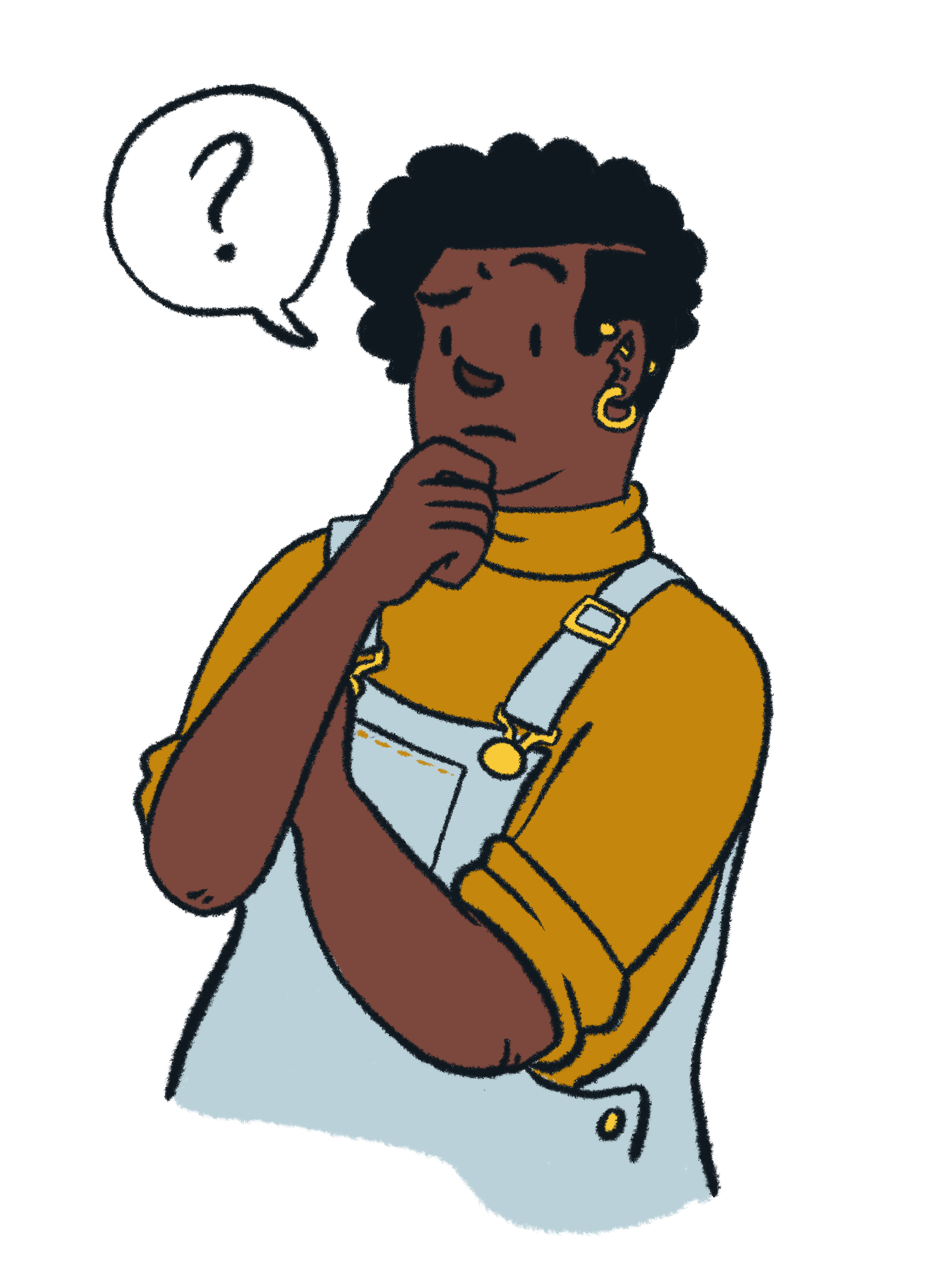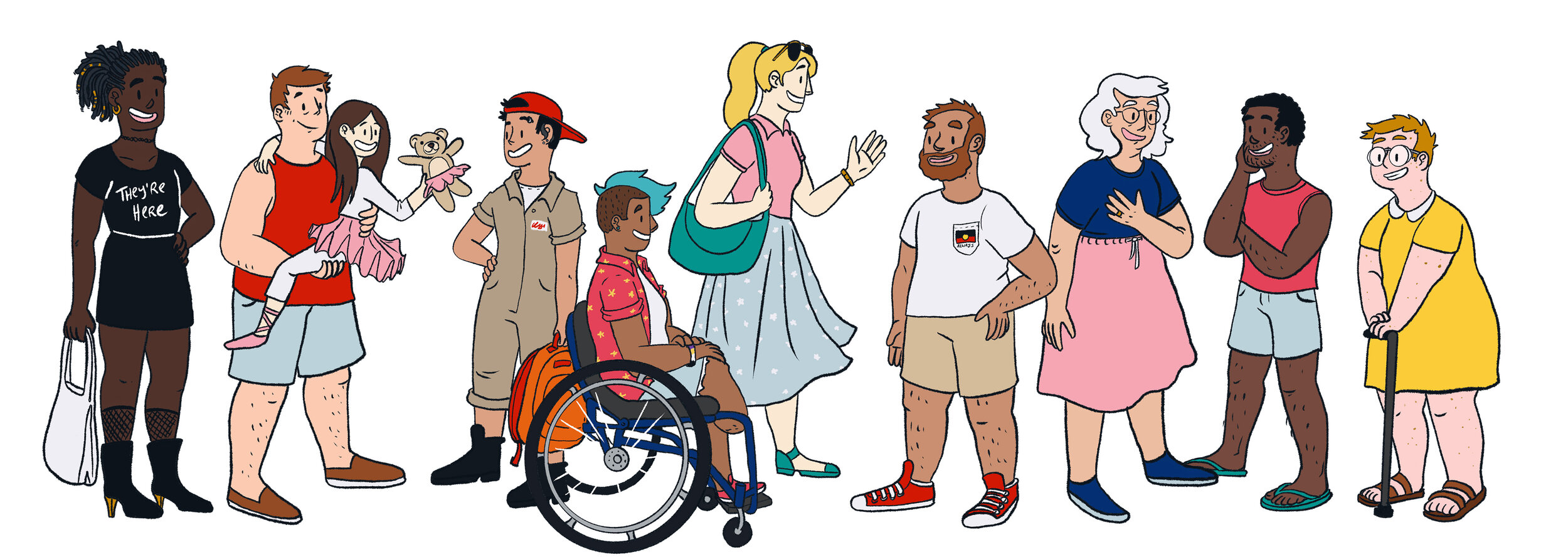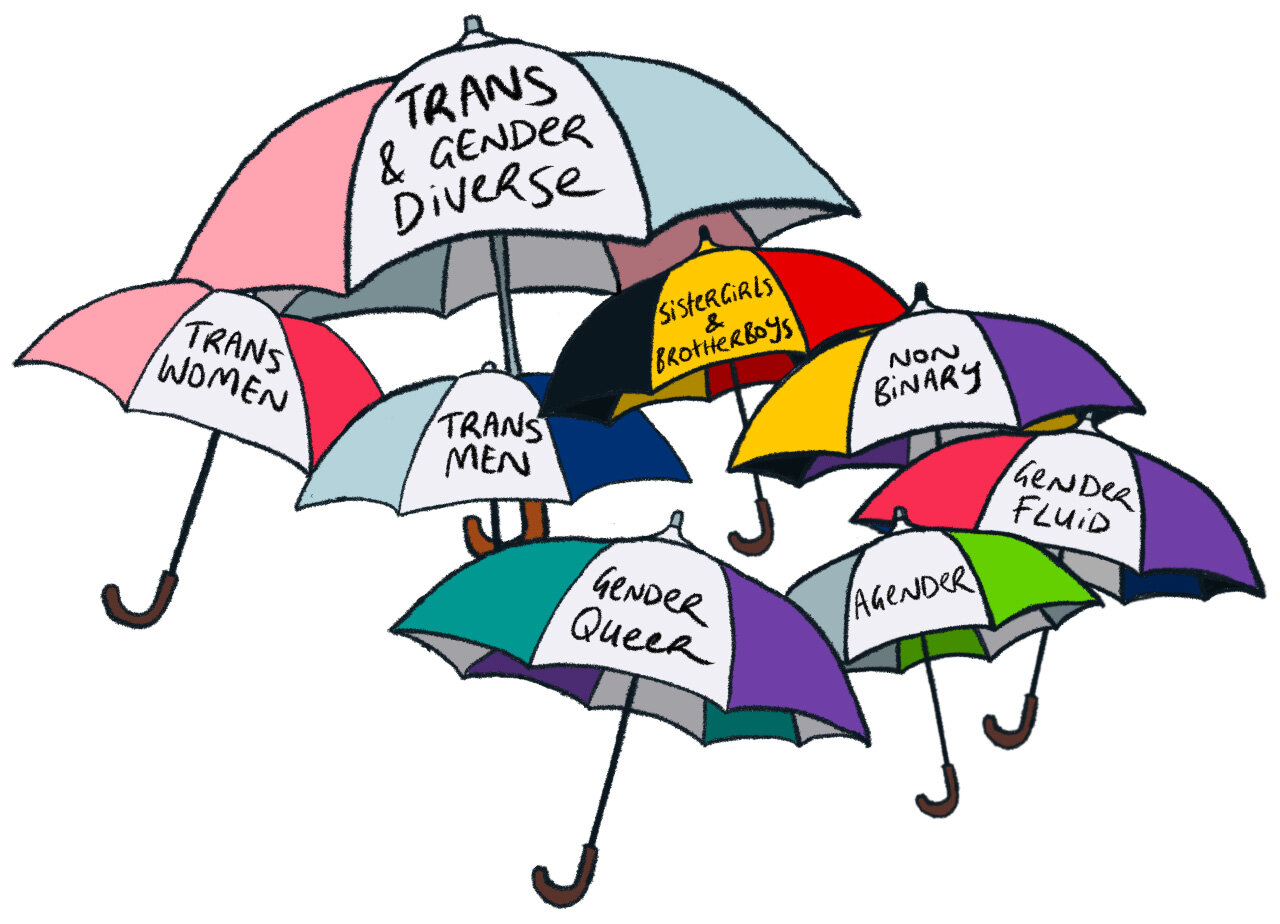What is trans?
Trans and gender diverse describes people whose gender differs from what was presumed for them at birth (sometimes referred to as “assigned at birth”)1. It may sound complex, but really it’s that simple.
There is no one correct way to be trans: it is an umbrella term that covers a large range of genders such as being non-binary, genderqueer, a Sistergirl or Brotherboy, genderfluid, having a binary gender, and more. Make sure you head to our Trans Mob page to learn more about the First Nations trans experience.
Some trans people affirm their gender in social and legal ways, like changing their name or wearing new clothes and updating their legal identity, and some affirm their gender in medical ways, like being on hormones or having surgeries, but some trans people don’t affirm their gender in ways that are visible to the outside world at all.
Some trans people come out as kids, others come out later on, and some don’t ever feel a need to, or like we can, be publicly out at all. Some trans people are super comfortable with their gender or trans identity, and others can struggle with it a lot, which can be made much tougher if we aren’t well-supported by the people/allies around us.
What does 'trans woman' mean?
A trans woman is someone who is a woman, or has a present experience of womanhood, and who was presumed to be male at birth. This can include trans women, trans feminine people, and more.
What does 'trans man' mean?
A trans man is someone who is a man, or has a present experience of manhood, and who was presumed to be female at birth. This can include trans men, trans masculine people, and more.
What does 'non-binary' mean?
A non-binary person is someone who is not exclusively male or female. This includes people who have no binary gender at all (eg. sit entirely outside of male or female), and people who have some relationship to binary gender, such as some trans feminine and trans masculine people.. Some people might identify across binary and non-binary genders. It’s important to remember that concepts of gender are different across cultural groups, and we continue to look to trans mob to show the way.
Sometimes people might depict genders on a scale, or spectrum, such as from male to female, masculine to feminine, or a triangle of man, woman, and non-binary. While this can be a really helpful way of visualising gender for some people, gender can be more complex than any chart could show, and that’s part of what makes it wonderful!
Binary gender
Male and female are the most common genders, and are often referred to as binary genders, which are different from non-binary genders, eg. Genders that are not male or female, or not exclusively male and female.So is being trans a separate gender?
The short answer is: not really!
The concept of gender experience describes the relationship between a person’s gender, and the gender they were presumed at birth. Most people have a cis experience of their gender, and some have a trans experience of their gender. In some cultures around the world there are 3, 4, or more different distinct genders.
In many cases, trans should be used as an adjective: just like how you’d call someone a tall woman, or a beautiful woman, you’d call them a transgender woman.
A good way to think about it is that for many trans people, being trans is describing their journey and not their destination.
Trans / transgender, adjective
1: used to describe someone’s experience of their gender, rather than their gender itself.
Hakeem is a trans; Monica is a transwoman;
Gemma is trans; Mike is a trans man;
Cis / cisgender, adjective
1: used to describe someone’s experience of their gender, rather than their gender itself.
Geoff is a cis; Amy is a cisperson;
Aisha is cis; Oliver is a cis man;
However, some people also do feel like being trans or transgender is an important destination too. This is a really personal experience, and it’s important to use the language that people use for themselves when talking to and about them.
For non-binary and genderqueer people, their experience of gender may be partially or completely separate from the binary of male and female, and this can include identifying with ‘being trans’ as a way of describing their gender.
In order to collect helpful and accurate gender data, it’s important to ask about gender and transgender status separately, rather than confusing the two.
Gender:
Man or Male
Woman or Female
Non-binary
I use a different term (please specify): _______________
Prefer not to answer
At birth, you were recorded as:
Male
Female
Another term (please specify)
Prefer not to answer (inclusion optional)
Why do we use umbrella terms?
“Umbrella terms” are words that are used to describe a large range of concepts or experiences in simplified terms. For example, painting is an umbrella term that can be used to talk about oil paintings and watercolours, detailed brushwork to splatter art, and even changing the colour of a house.
Similarly, trans and gender diverse, trans, and transgender are umbrella terms for a population of people whose gender is different to what was presumed for them at birth. The term trans is inclusive of binary trans people (women and men who are trans), non-binary trans people, Sistergirls and Brotherboys.
Umbrella terms are an often imperfect but helpful solution to trying to talk about a wide range of experiences that are closely related in some ways, but very different in others. No two trans people will have the same experience of being trans, but we have similar experiences that may not be shared with cis people.
Trans and gender diverse people are also a socially and legally marginalised population, and coming together under these umbrellas of identity is an important way of advocating for ourselves and each others’ rights despite the differences we may have.
Why does the terminology keep changing?
Trans people have existed for a long time, since people have existed, but the words used to describe groups of people, or by groups to describe themselves, can only develop when enough people are connected and visible.
Over the years, trans people have been referred to by others and by ourselves in many different ways, and with a range of different words. Many of these have come from the words doctors and researchers have invented to talk about and describe trans people, and other words were coined by trans communities to talk about ourselves.
The language a person uses may vary for a range of reasons. Some trans people position ‘being trans’ as a history or experience, rather than an identity, and consider their gender identity as simply being female, male or a non-binary identity. Some connect strongly with their trans experience.
Information for Allies
It’s important to always use the language that trans people use for themselves. It can also be helpful to ask yourself why you’re talking about someone’s gender or identity to others, and if you would do the same thing about a cisgender friend? If not, it’s probably better to just say “My friend Kelly”, rather than “My friend who is also trans, Kelly”. Much easier!
How many trans people are there?
High quality empirical evidence and data (such as from a Census) about the size of the NSW trans population are limited. This is because trans people aren't adequately included in data collection.
However, a systematic review of studies published internationally from 2009-2019 found estimates ranged from 0.5 to 4.5% among adults. This could mean that there are even hundreds of thousands of trans and gender diverse adults in NSW alone2.
These numbers increased across all trans and gender diverse categories over time, not because there are suddenly more trans people, but because the families, communities and spaces we reveal our genders to are slowly becoming safer for us.
This doesn't mean the world is now safe for trans people to exist in, indeed this couldn't be further from the truth, however, slowly but surely cis people are beginning to see that the trans experience does not pose a threat.
Are trans and intersex the same thing?
No, intersex and trans are not the same thing.
Intersex people are born with naturally occurring and very normal differences of chromosomes, gonads (ovaries and testes), hormones, and/or genitals. There are more than 40 different ways to be intersex. People may find out they are intersex at many different points including when they are born, during puberty, when trying to conceive a pregnancy, by random chance, and some people never find out.
Some intersex people are trans, and most are cis, just as some intersex people find solidarity in the human rights movement of LGBTQA+, and many don’t connect with the rainbow at all.
Some intersex people who have rejected the sex assigned to them at birth may identify as transgender or gender diverse, while others may see themselves as correcting a mistake made by doctors without their consent when they were children.
Intersex Human Rights Australia 3
ACON affirms the Darlington Statement and we stand in solidarity with the vision that all people have a right to be in charge of their own body and self without others making decisions for them. We support full agency, bodily autonomy and self-determination for all.
For more information about intersex, including being an intersex ally, you can visit Intersex Human Rights Australia.
Links
1 Trans - Merriam-Webster Dictionary
3 Intersex for allies - Intersex Human Rights Australia
Rethinking How We Talk About Sex and Gender - Scarleteen
The Science of Gender Is Rarely Simple - NY Times
Debunking “Trans Women Are Not Women” Arguments - Julia Serano
Transgender People and “Biological Sex” Myths - Julia Serano
InQueery: What Does the Word "Transgender" Mean? - Them
9 questions about trans issues you were too embarrassed to ask - Vox
All illustrations on this page by Briar Rolfe



